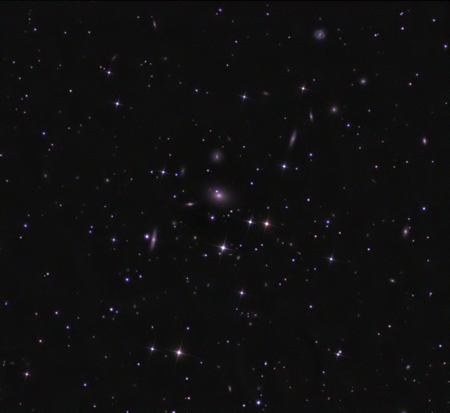Abell Glaxy Cluster AGC 2666
I shot this on a windy night in October 2009. The wind meant that I couldn't do long exposures, so I had to keep my sub length down, and clouds rolled in cutting the session short while shooting RGB.
I was using the scope/camera combination just to look around and saw
NGC 7768 (the brightest galaxy, mag 12.3) and others on the planetarium
program so decided to have a look.
The whole region looked pretty photogenic so I grabbed some data.
Well worth going back to and going deep I think.
NGC 7768 lies 230 million light years away from us.
230 million years is the length of 1 orbit of the galaxy by the sun, and
at this time the continents that we know today were just starting to break
apart from the supercontinent called Pangea.
This was the early Triassic, and 20 million years before this the Triassic-Permian
extinction event had taken place, wiping out 90% of all plants and animals
both in the sea and on land.
There were no mammals, birds or lizards, nor grasses or flowering plants,
and the ground was covered in a mixture of ferns and mosses.
The first dinosaur fossils come from this time, the jawbones of 3 animals,
and are thought to be of Kangaroo sized creatures called Prosauropods.
The Prosauropods were the ancestors of the giant plant eaters like Diplodocus,
Brachiosaurus, and the creature now known as Apatosaurus, which will always
be known by those of us above a certain age as the wonderful Brontosaurus.
Click on image below for full size version
Imaging Details.
TMB 152, Atik 16HR.
L. 12 x 5 minutes
R. 4 x 4 minutes
G. 4 x 5 minutes
B. 3 x 6 minutes.
